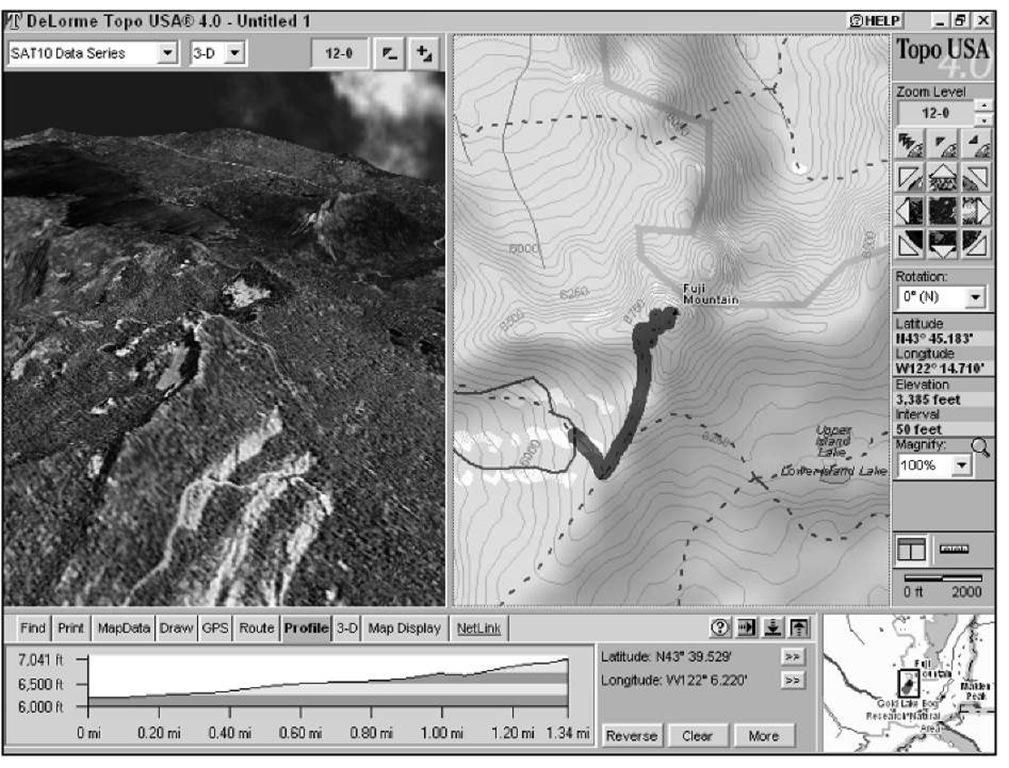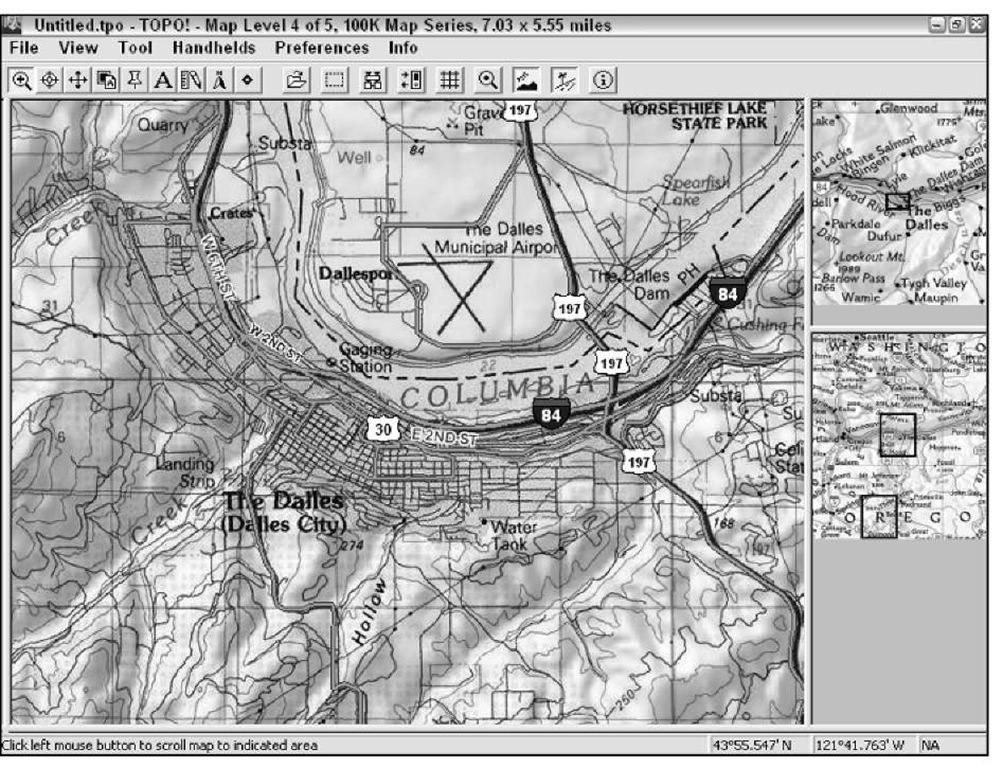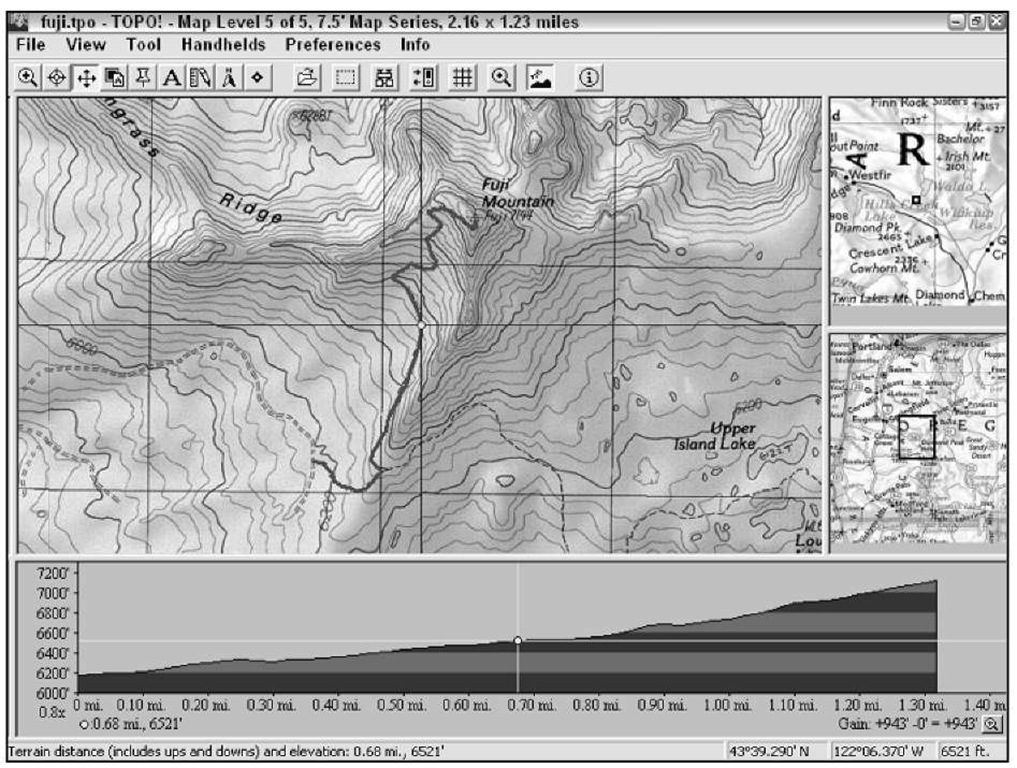In addition to Maptech and its topographic mapping programs, DeLorme and National Geographic also offer software that’s suited for off-road use. As previously mentioned, most topographic map programs have the same basic features; the biggest difference is their user interface. Because I don’t have the time to cover the other mapping programs in detail, this section provides a brief description of a few popular programs, shows some screenshots to give you an idea of what the user interface is like, and provides manufacturer Web sites to get more product information. When it comes to choosing a topographic map program, you really can’t go wrong with any of the programs mentioned in this topic.
You can’t upload detailed maps to your GPS receiver from any of the programs discussed in this topic. GPS receivers that display maps can use only proprietary maps (sold by the GPS manufacturer), and these tend to show considerably less detail than maps you can display on your PC. Several topographic map software companies do offer products that you can use with a Pocket PC/Palm PDA and GPS receivers that can display detailed topographic maps just as they appear on a PC screen.
DeLorme mapping products
DeLorme, well known for its Street Atlas USA road navigation software, also makes two topographic mapping programs: Topo USA and 3-D TopoQuads. DeLorme uses the same user interface for its entire line of consumer mapping products, so if you’re a happy user of Street Atlas USA and are looking for a map program for off-road use, it makes sense to keep things in the DeLorme family.
DeLorme was one of the first vendors to offer customers a choice of map data on CDs or DVDs. If you have a DVD player on your PC, DVDs are far more convenient because you don’t have as many discs to keep track of, and you don’t have to swap discs as often to view maps of different areas.
DeLorme topographic mapping products can interface with GPS receivers, display 3-D maps, search for locations, provide elevation profiles, and plan for trips just like other map programs. These two unique features in the program are especially useful:
Satellite imagery: DeLorme sells 10-meter resolution color satellite data for each state. When you use the images with DeLorme mapping products, you can view the satellite photos side by side with topographic maps in 2-D or 3-D. (See an example produced by Topo USA in Figure 13-7.)
Mural printing: If you need to produce a large map for a presentation, the programs support printing mural maps that are up to three pages high by three pages wide that you can join to make a large map.
To read more about DeLorme’s mapping programs, visit www.delorme.com.
Topo USA
Topo USA provides 1:100,000 scale topographic maps of the entire United States (for around the same price as a collection of 1:24,000 scale digital maps for a single state). Remember, you don’t get as much detail as you would with a 1:24,000 scale map, but there’s enough detail for rudimentary navigation and to use as a general reference.
Figure 13-7:
3-D satellite image with topographic map displayed in Topo USA.
The Topo USA maps are vector-based (drawn with lines and shapes), so they don’t have the crisp appearance of a USGS digital raster map. However, DeLorme vector maps tend to have more updated road information because some of the scanned raster maps are based on data from maps made over 20 years ago.
3-D TopoQuads
3-D TopoQuads provides more detailed maps that are sold by state or region. The maps are displayed as vector maps until you zoom in far enough, and then they become 1:24,000 scale USGS scanned digital raster maps. (See an example of a map, including 2-D and 3-D views, in Figure 13-8.)
National Geographic mapping products
Many children got their first introduction to maps from National Geographic magazines. Each month, a carefully folded paper map of somewhere foreign and exotic came nestled inside the magazine. National Geographic is still in the map business, now producing several topographic map programs.
Figure 13-8:
2-D and 3-D display of 1:24,000 topographic maps in 3-D TopoQuads.
I was one of those kids that got hooked on National Geographic maps when I was growing up, and I still like them today. The company’s map software is easy to use and strikes a nice balance of having just the right number and types of features, without having too many whistles and bells.
National Geographic software has all the same basic features as other mapping programs, such as GPS support, route planning, printing maps, and searching for locations. The only exception is that National Geographic programs currently use only relief shading to show elevation and don’t render 3-D map images.
National Geographic has a number of paper and electronic map products available; visit www.nationalgeographic.com/maps. The two digital map products that you’ll find the most practical for backcountry use are Back Roads Explorer and TOPO!
Back Roads Explorer
Back Roads Explorer contains 1:100,000 scale topographic maps and larger overview maps of the entire United States. In addition to terrain data, the software also has road and street data that you can overlay on top of a map, including paved and unpaved roads. (An example is shown in Figure 13-9.)
Figure 13-9:
Back Roads Explorer 1:100,000 scale map with overlaid roads.
Unlike DeLorme’s Topo USA, Back Roads Explorer uses raster maps (scanned versions of paper maps), which contain more detail. If you prefer more of a traditional looking map to one that looks like it was computer-generated, you’ll like Back Roads Explorer.
Raster maps take up more disk space than vector maps because they’re scanned images of paper maps. Vector maps are smaller because they’re composed of lines and shapes. For example, the raster map data for the entire United States that comes with Back Roads Explorer fits on 17 CDs, but the same vector data in Topo USA comes on 6 CDs.
With the option of overlaying up-to-date roads over topographic maps, Back Roads Explorer is ideal for basic navigation and is especially well suited for 4 x 4 enthusiasts who use a laptop and GPS receiver.
TOPO!
National Geographic’s TOPO! line of software provides 1:24,000 maps for each of the states and is comparable with Maptech’s Terrain Navigator and DeLorme’s 3-D TopoQuads products. (A screenshot of a TOPO! 1:24,000 scale map is shown in Figure 13-10.)
Figure 13-10:
TOPO! 1:24,000 scale topographic map.
One feature that I especially like in the TOPO! products is mapXchange. You can visit the National Geographic Web site and select the state you have TOPO! maps for. A list of hikes and other outdoor activities is displayed with descriptions, and you can freely download files that contain waypoints and routes you can use with TOPO! If you like, you can also upload your own files of places you’ve been to share with other outdoor enthusiasts.




